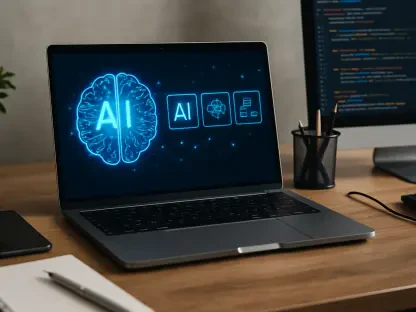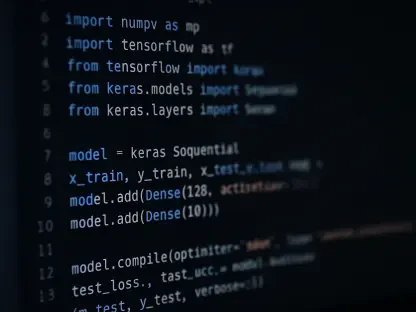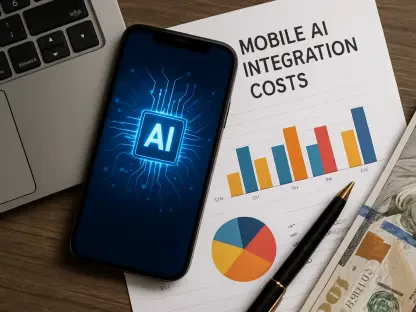Setting the Stage for a Security Dilemma
Imagine a software development team racing against a tight deadline, leveraging cutting-edge AI tools to churn out thousands of lines of code in mere hours, only to discover post-deployment that a critical vulnerability has exposed sensitive data to attackers. This scenario is no longer a hypothetical concern but a stark reality for many organizations. With 34% of companies now generating over 60% of their code through AI-powered assistants, the speed and efficiency of development have soared, yet so have the risks. This review delves into the transformative world of AI code generation, dissecting its features, performance, and the profound security challenges it introduces to DevSecOps practices.
The rapid integration of AI into coding workflows has reshaped the software development landscape, promising unprecedented productivity gains while simultaneously raising alarms about unchecked vulnerabilities. As organizations grapple with balancing innovation and safety, understanding the implications of this technology becomes paramount. This analysis aims to provide a comprehensive look at how AI code generation operates, its benefits, and the blind spots that threaten to undermine years of security investments.
Unpacking the Technology: How AI Code Generation Works
At its core, AI code generation relies on advanced machine learning models and natural language processing to interpret developer prompts and produce functional code snippets or entire applications. These tools, often referred to as coding assistants, learn from vast datasets of existing codebases to predict and suggest solutions, automating repetitive tasks with remarkable accuracy. Their ability to adapt to various programming languages and frameworks makes them indispensable in modern development environments.
The adoption of this technology has accelerated due to the pressing need for speed in software delivery. Developers under constant pressure to meet deadlines find AI tools to be a lifeline, capable of slashing coding time significantly. However, this reliance introduces complexities, as the logic and patterns in AI-generated code often differ from human-written counterparts, creating challenges for traditional security mechanisms.
Beyond mere automation, AI code generation integrates seamlessly into integrated development environments (IDEs), offering real-time suggestions and error corrections. This functionality, while a boon for efficiency, raises questions about the oversight required to ensure that the generated code adheres to security best practices. The technology’s rapid evolution continues to outpace the frameworks designed to govern its use, setting the stage for potential risks.
Performance and Features: Productivity versus Vulnerability
Accelerating Development with AI Tools
One of the standout features of AI code generation is its capacity to boost developer productivity by automating mundane and repetitive coding tasks. Data indicates that organizations leveraging these tools can achieve significant time savings, with many reporting a marked increase in output. This acceleration is particularly valuable in high-pressure sectors like technology and finance, where innovation and speed are critical to maintaining a competitive edge.
The intuitive nature of AI assistants further enhances their appeal, as they provide context-aware code suggestions that align with project requirements. This capability not only reduces manual effort but also allows developers to focus on higher-level problem-solving. Yet, this very strength can become a liability when speed overshadows the need for thorough security vetting, often leading to the deployment of untested code.
Security Gaps in Generated Code
A critical drawback of AI-generated code lies in its tendency to evade detection by conventional security tools like static application security testing (SAST). These tools, designed primarily for human-written code, struggle to identify vulnerabilities in the unique structures produced by AI models. As a result, critical flaws often slip through the cracks, posing substantial risks to application integrity.
The real-world impact of these gaps is staggering, with 98% of organizations reporting breaches linked to vulnerable code in the past year. This alarming statistic underscores the urgent need for updated security approaches tailored to the nuances of AI outputs. Without such measures, the rush to capitalize on productivity gains can lead to costly security failures.
Moreover, the lack of governance exacerbates these issues, as only 18% of organizations have established policies for AI tool usage. This absence of oversight means that developers may unknowingly introduce vulnerabilities into production environments, undermining the foundational “shift left” principle of DevSecOps that emphasizes early risk mitigation.
Emerging Risks and Industry Trends
The increasing dependence on AI code generation tools, despite inadequate governance, signals a troubling trend in the software development ecosystem. Many organizations prioritize delivery timelines over security protocols, resulting in a culture where risks are often overlooked until a breach occurs. This shortsighted approach threatens to erode trust in AI-driven development processes.
Another concerning pattern is the slow adoption of security-first mindsets within development teams. Despite years of advocacy for integrating security into every stage of the software lifecycle, cultural resistance persists, compounded by insufficient training and tools that fail to align with developers’ workflows. This lag creates a fertile ground for vulnerabilities to proliferate.
Looking ahead, the rise of agentic AI—systems capable of autonomous decision-making—introduces new attack surfaces that demand proactive measures. Without robust guardrails, these advanced tools could amplify existing risks, making it imperative for the industry to develop innovative solutions and frameworks to address emerging threats.
Challenges in Securing the AI-Driven Landscape
Securing AI-generated code presents unique technical hurdles, as current DevSecOps tools are often ill-equipped to handle the specific risks associated with this technology. High rates of false positives in security scans lead to developer frustration and disengagement, further complicating efforts to enforce consistent risk management practices across teams.
Organizational barriers also play a significant role in hindering progress. A lack of clear governance structures means that AI tool usage often goes unmonitored, leaving blind spots in security postures. Additionally, insufficient education on the risks of AI-generated code contributes to a workforce that may not fully grasp the importance of vigilance in their daily tasks.
Efforts to overcome these challenges are underway, with initiatives focused on creating tailored security solutions and policies. However, the pace of innovation in AI code generation continues to outstrip these developments, highlighting the need for a concerted push toward integrating security seamlessly into development environments without stifling productivity.
Final Thoughts and Path Forward
Reflecting on this exploration of AI code generation, it becomes evident that while the technology offers transformative benefits in accelerating software development, it also exposes significant security vulnerabilities that challenge established DevSecOps frameworks. The impressive productivity gains stand in stark contrast to the alarming breach statistics and governance gaps that plague many organizations.
Moving forward, actionable steps emerge as critical for bridging these divides. Prioritizing the development of autonomous application security solutions that automatically prevent vulnerabilities offers a promising avenue to reduce developer burden. Equally important is the need to foster cultural change through targeted training programs that empower teams to embrace security without sacrificing efficiency.
Additionally, adopting comprehensive governance models, such as the OWASP AI Vulnerability Scoring System, provides a structured approach to assessing and mitigating risks specific to AI-generated code. By focusing on visibility into tool usage and tailoring policies to different code sources, organizations can better safeguard their applications, ensuring that the advantages of AI are harnessed responsibly in an ever-evolving digital landscape.









